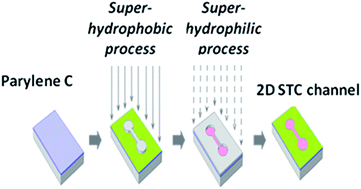A 2D approach to surface-tension-confined fluidics on parylene C†
Abstract
In the present study a new, facile and cheap method to obtain a 2D surface-tension-confined fluidic system on substrates conformally coated by parylene C is presented. It is based on the use of poly(dimethylsiloxane) (PDMS)-based soft masks obtained by molds produced by a 3D-printer. These masks, applied alternatively onto a parylene C-coated silicon substrate together with appropriate plasma treatments permit to obtain a superhydrophilic pattern on a superhydrophobic background, in which pure water, water-based solutions and polar solvents can flow. The flow of these liquids is strictly confined and is driven into the superhydrophilic pattern only by the differences in surface energy between it and the background, without any confinement effect provided by walls or capillary-driven channel, that are completely missing. According to the proposed fabrication method, all the desired fluidic systems can be fabricated in an easy and cheap way. The developed method for 2D surface-tension-confined fluidics on parylene C permits to obtain a highly versatile platform which can be applied on all desired substrates, without the need to etch the polymer surface in order to obtain channel walls, paving the way to employ green, easily available and cheaper substrates, such as cellulose for paper-based fluidics applications, improving, at the same time, the biopolymer surface properties.



 Please wait while we load your content...
Please wait while we load your content...